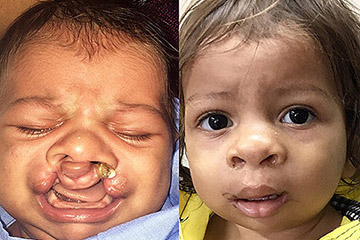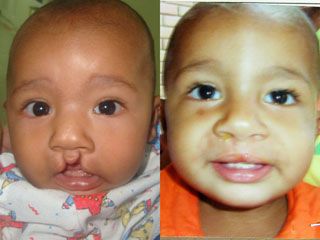New York Center for Facial Plastic Surgery
Schedule a consultation

Information About Cleft Lip and Cleft Palate Surgery with Dr. Andrew Jacono in New York City.
Dr. Andrew Jacono’s Humanitarian Missions: Transforming Lives Through Plastic Surgery for Children in Need. Watch the inspiring before and after journey.
Cleft lip and cleft palate are birth defects. They occur during the developmental process in the womb. Normally, the nose and mouth of a baby develop between the first 6 and 12 weeks of growth. However, for cleft lip and cleft palate deformities, parts of the lips and the roof of the mouth don’t grow together.
In the case of a cleft lip, this causes a physical separation in the upper lip. This causes a fissure in the roof of the mouth.
Researchers believe that these facial deformities are caused by genetic and environmental factors. However, in most children, a definite cause is unlikely to be discovered.
Parents with a genetic history of cleft lip or cleft palate are likelier to have a child with a cleft. Women who smoke cigarettes, drink alcohol, or use drugs during pregnancy are also at a higher risk of giving birth to a baby with a cleft. Males are more likely to have a cleft lip, while females are more likely to have a cleft palate.
Lastly, people of Asian descent are at the highest risk of having a cleft, while people of African descent are at the lowest risk.

Children with palate deformities experience a number of difficulties. These include:
left lip and cleft palate make it more difficult for babies to eat. Although most infants with a cleft lip can breastfeed, they may have trouble latching onto the nipple. A cleft palate can make sucking much harder.
Babies with a cleft palate are at an especially high risk of developing hearing loss and middle ear fluid infections.
The palate is used to form sounds. Therefore, a cleft palate can cause speech difficulties. For example, the voice can sound too nasal. This occurs because the soft palate is not able to properly close off the mouth from the nose while speaking. Air thus escapes through the nose.
If the cleft lip or cleft palate extends through the upper gums, tooth development may be severely affected.
Medical professionals with cleft lip and palate expertise have formed teams all over the country to help parents plan for their child’s care. Usually, members of a child’s cleft lip and palate treatment team include:
New York Center for Facial Plastic Surgery
Schedule a consultation

Surgical treatment for cleft lip and cleft palate is the most direct way to address physical concerns.
During surgery, Dr. Jacono makes an incision on either side of the cleft, from the lip to the nostril. The two sides of the lip are then sutured together. Bilateral cleft lips require a different surgery.
Cleft palate surgery involves drawing tissue from either side of the mouth to rebuild the palate. It requires 2 or 3 nights in the hospital, with the first night spent in the intensive care unit. Overall, the surgery aims to separate the oral and nasal cavities. This separation involves the formation of a valve that is both airtight and watertight. The valve is necessary for normal speech. Surgical repair also preserves facial growth and the development of the proper dentition.
Dr. Jacono and other surgeons agree that corrective surgery should be performed when the patient is younger than 1 year. This is before significant speech development occurs. The potential benefits of an intact lip and palate outweigh the complications of early closure. Surgery requires general anesthesia.
The necessity for further operations depends on the cleft’s shape and severity, and on the thickness of the tissue. Some children with a cleft palate require more surgeries to improve their speech. Additional procedures may improve the appearance of the lip and nose, close openings between the mouth and nose, help to breathe, and stabilize the jaw. Subsequent surgeries are usually scheduled 6 months apart to allow the child to heal.
Dr. Jacono is a dual-board certified facial plastic and reconstructive surgeon who volunteers with “BEYOND OUR BORDERS” to bring underprivileged children from third-world countries to the United States for surgery.
He also volunteers with “HEALING THE CHILDREN” to coordinate mission trips to third-world countries so that children can receive surgeries unavailable to them due to a lack of medical and financial resources.
This child had a unilateral cleft lip deformity that was repaired and a one year follow up photo.

This child had a bilateral cleft lip deformity that was repaired and a one year follow up photo.


Accessibility: If you are vision-impaired or have some other impairment covered by the Americans with Disabilities Act or a similar law, and you wish to discuss potential accommodations related to using this website, please contact our Accessibility Manager at (212) 570-2500 .